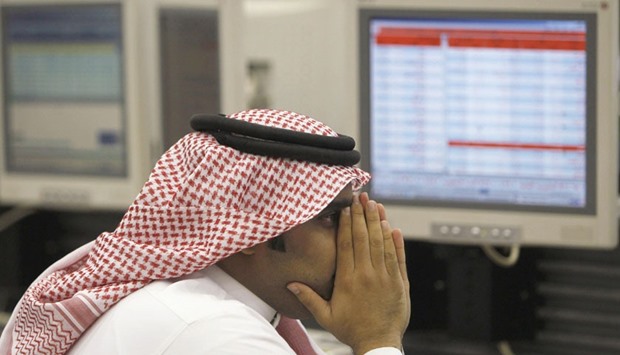Gulf stock markets fell sharply yesterday, with Saudi Arabia plunging more than 4% and other major markets losing at least 3%, because of a fresh slide of oil prices and worries about the health of the regional and global economies.
Brent oil sank more than 4% to below $33 a barrel for the first time since April 2004. That was lower than many investors expected just a few days ago and if such prices persist, Gulf state finances will come under fresh pressure.
Saudi Arabia’s 2016 state budget, released last week, projected an $87bn deficit - assuming oil averaging about $40. Lower prices could force Riyadh to deplete its foreign reserves faster, adding to investor jitters.
This prospect caused the Saudi riyal to hit a record low against the US dollar in the one-year forwards market yesterday, while the cost of insuring against a Saudi sovereign debt default rose.
The Saudi stock index sank 4.5%, its biggest daily drop since August, to close at 6,225 points, its lowest finish since December 2011. It closed within just 35 points of the day’s low.
Only three out of 166 traded Saudi stocks rose. Second-tier banks were hit particularly hard on concern about an economic slowdown; Al Jazira Bank dropped 5.8%.
United Electronics, a popular play on Saudi consumer demand, plunged 9.4%.
Heavily weighted petrochemical stocks sagged as cheap oil will erode producers’ margins, and because of worries about demand in China. Also, the Saudi state budget sought to save money by hiking natural gas feedstock prices for the industry.
Blue chip Saudi Basic Industries lost 3.2% and the sector’s index sank 3.3%.
“The multi-year low oil prices, weak demand in key markets and the recent change in feedstock prices are expected to significantly impact the sector’s profitability in 2016,” analysts at NCB Capital said in a note.
They estimated the sector’s net income would fall 13.6% this year, with gross profit margins hit by between 2 and 8 percentage points. They also said the profit fall could be more severe if China’s economy weakened or oil prices averaged less than $52 a barrel this year.
Advanced Petrochemical rose 1.2%, however, after NCB Capital upgraded it to “overweight” from “neutral”, citing a favourable feedstock mix, its operating efficiency and an attractive dividend yield.
Analysts at Al Jazira Capital said Advanced Petrochemical, which uses liquid gas feedstock, would outperform producers using ethane as feedstock; the domestic price of ethane rose to $1.75 per million British thermal units from 75 US cents in the state budget.
The seasonally adjusted Emirates NBD Saudi Arabia Purchasing Managers’ Index, published yesterday, showed growth in the non-oil private sector falling to its slowest pace in December since the survey was launched in August 2009.
The slowdown appears to have been caused by a cut-back in Saudi state spending late last year. The 2016 budget contained more cuts, and additional austerity steps could be taken if oil continues falling.
“We suspect that this is probably just a sign of things to come,” London-based Capital Economics said in a report on the Saudi PMI, predicting that a fiscal squeeze would reduce growth further this year.
Economies and governments in the UAE and Qatar, which have stronger state finances, look better placed to cope with an era of low oil prices. But their markets were caught up in the selloff too, as weakness in Saudi Arabia could have an impact throughout the region.
The Emirates NBD UAE Purchasing Managers’ Index for December showed business activity growth in the UAE slowing to a 40-month low.
Dubai’s index tumbled 3.4% in an almost indiscriminate sell-off; blue chip Emaar Properties sank 5.4%. Telecommunications firm du was bought as a defensive stock, however, rising 0.6%.
Abu Dhabi dropped 3.2% in a broad sell-off.
Egypt’s market was closed yesterday for a holiday.
Elsewhere in the Gulf, Kuwait’s index fell 1.6% to 5,475 points; Oman’s index dropped 0.5% to 5,365 points, while Bahrain’s index fell 0.7% to 1,202 points.

A Saudi trader monitors stocks at the Saudi Investment Bank in Riyadh (file). The Saudi stock index sank 4.5% yesterday, its biggest daily drop since August, to close at 6,225 points, its lowest finish since December 2011. It closed within just 35 points of the day’s low.


